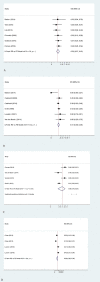Effectiveness of Medical Treatment of Cushing's Disease: A Systematic Review and Meta-Analysis
- PMID: 34603209
- PMCID: PMC8485729
- DOI: 10.3389/fendo.2021.732240
Effectiveness of Medical Treatment of Cushing's Disease: A Systematic Review and Meta-Analysis
Abstract
Objective: The objective of this systematic review was to evaluate the effectiveness and safety of pasireotide, cabergoline, ketoconazole, levoketoconazole, metyrapone, osilodrostat, and temozolomide for the treatment of Cushing's disease (CD).
Methods: The primary outcomes were the proportion of CD control, adverse events (AE), and reduction of urinary free cortisol. Search strategies were applied to Embase, Medline, and CENTRAL. Independent reviewers assessed the study eligibility, extracted data, and evaluated risk of bias. Standardized mean difference was calculated with 95% confidence interval (CI) for continuous data (i.e., pre- and post-intervention). Random meta-analyses for the proportion of CD control and AE were conducted.
Results: Twenty-nine controlled and non-controlled studies were included. No study with temozolomide and levoketoconazole and one study with osilodrostat fulfilled the inclusion criteria. The meta-analyses of proportion of CD control was 35% for cabergoline (95% CI: 27-43%, six studies, 141 participants), 44% for pasireotide (95% CI: 25-35%, eight studies, 522 participants), 41% for ketoconazole (95% CI: 36-46%, six studies, 450 participants), 66% for metyrapone (95% CI: 46-87%, four studies, 66 participants), and of 66.4% for osilodrostat (95% CI: 57.9, 74.3, 97 participants, one study). One study compared two different treatments (cabergoline vs. ketoconazole), and no statistical difference was observed in CD control (RR: 0.53, 95% CI: 0.15 to 1.87, 14 participants, very low certainty of evidence). The most frequent AE associated with pasireotide was hyperglycemia, dizziness and nausea with cabergoline and metyrapone, and elevated transaminases with ketoconazole.
Conclusion: The superiority of one drug over another could not be determined due to lack of controlled studies, but the proportion of disease control identified in our meta-analysis may support clinical decision. New therapeutic options should be investigated due to the limited efficacy and tolerability of the currently available medical treatment for patients with Cushing's disease.
Systematic review registration: https://www.crd.york.ac.uk/prospero/display_record.php?ID=CRD42020205567, identifier CRD42020205567.
Keywords: Cushing’s disease; cabergoline; ketoconazole; meta-analysis; metyrapone; pasireotide (SOM230); systematic literature review.
Copyright © 2021 Simões Corrêa Galendi, Correa Neto, Demetres, Boguszewski and Nogueira.
Conflict of interest statement
The authors declare that the research was conducted in the absence of any commercial or financial relationships that could be construed as a potential conflict of interest.
Figures
Similar articles
-
Osilodrostat (Isturisa) for Cushing's disease.Med Lett Drugs Ther. 2021 Feb 8;63(1617):21-23. Med Lett Drugs Ther. 2021. PMID: 33647005 Review. No abstract available.
-
Medical management pathways for Cushing's disease in pituitary tumors centers of excellence (PTCOEs).Pituitary. 2025 Jan 29;28(1):23. doi: 10.1007/s11102-024-01485-x. Pituitary. 2025. PMID: 39881009 Free PMC article.
-
How best to monitor the specific side effects of medical treatments of Cushing's disease.Best Pract Res Clin Endocrinol Metab. 2022 Dec;36(6):101718. doi: 10.1016/j.beem.2022.101718. Epub 2022 Nov 14. Best Pract Res Clin Endocrinol Metab. 2022. PMID: 36435719 Review.
-
Advances in pharmacological treatment of Cushing's disease.Zhong Nan Da Xue Xue Bao Yi Xue Ban. 2024 Jul 28;49(7):1023-1033. doi: 10.11817/j.issn.1672-7347.2024.240306. Zhong Nan Da Xue Xue Bao Yi Xue Ban. 2024. PMID: 39788490 Free PMC article. Review. Chinese, English.
-
Ketoconazole as second-line treatment for Cushing's disease after transsphenoidal surgery: systematic review and meta-analysis.Front Endocrinol (Lausanne). 2023 May 8;14:1145775. doi: 10.3389/fendo.2023.1145775. eCollection 2023. Front Endocrinol (Lausanne). 2023. PMID: 37223017 Free PMC article.
Cited by
-
Budget impact analysis of cabergoline for medical treatment of Cushing's disease in Brazil.Arch Endocrinol Metab. 2024 Jul 30;68:e230311. doi: 10.20945/2359-4292-2023-0311. eCollection 2024. Arch Endocrinol Metab. 2024. PMID: 39420893 Free PMC article.
-
Evaluation of ketoconazole as a treatment for Cushing's disease in a retrospective cohort.Front Endocrinol (Lausanne). 2022 Oct 7;13:1017331. doi: 10.3389/fendo.2022.1017331. eCollection 2022. Front Endocrinol (Lausanne). 2022. PMID: 36277689 Free PMC article.
-
Levoketoconazole.Hosp Pharm. 2022 Oct;57(5):605-614. doi: 10.1177/00185787221115368. Epub 2022 Aug 2. Hosp Pharm. 2022. PMID: 36081533 Free PMC article.
-
Safety assessment of Osilodrostat: The adverse event analysis based on FAERS database by means of disproportionality analysis.PLoS One. 2025 Aug 7;20(8):e0329088. doi: 10.1371/journal.pone.0329088. eCollection 2025. PLoS One. 2025. PMID: 40773444 Free PMC article.
-
Possible Clinical Effects of Ketoconazole on Sorafenib-induced Hand-Foot Skin Reaction and Cytoprotection Mechanisms of Antifungal Agents against Multikinase Inhibitor-induced Keratinocyte Toxicity.Acta Derm Venereol. 2025 Apr 28;105:adv40697. doi: 10.2340/actadv.v105.40697. Acta Derm Venereol. 2025. PMID: 40289816 Free PMC article.
References
-
- Petersenn S, Beckers A, Ferone D, van der Lely A, Bollerslev J, Boscaro M, et al. . Therapy of Endocrine Disease: Outcomes in Patients With Cushing's Disease Undergoing Transsphenoidal Surgery: Systematic Review Assessing Criteria Used to Define Remission and Recurrence. Eur J Endocrinol (2015) 172(6):R227–39. doi: 10.1530/EJE-14-0883 - DOI - PubMed
Publication types
MeSH terms
Substances
LinkOut - more resources
Full Text Sources



